|
|
Review of GSM-handset Samsung E570
Live photos of Samsung E570
Sales package:
- Handset
- Battery
- Charger
- User Guide
- Carrying strap
- Carrying pouch (availability varies by region)
When it comes to Samsung’s La Fleur collection, Samsung E570’s positioning is somewhat out of place – following the widely spread stereotype that for more features the maker charges more, the E570 should be inferior to Samsung E500 functionality-wise. At the same time, being a lucky owner of a higher index, the E570 proves to be a wholly different story, on top of that it is positioned as the women-range flagship by the Samsung. So as a matter of fact this handset is a successor to Samsung E530, whose prototype was known as Aqua, while the updated edition goes by the name of “Aqua Slim”


The design shown off by Samsung E570 is somewhat similar to its predecessor, yet it is so only at a glance – this model looks much more preferable. A black glossy plastic framing adds some points to the handset’s bank as well, but not only does it look nice, it also protects a vertically-orientated OLED-display. The market has seen not so many solutions sporting the same looks, but the women-only offerings are seemingly the field where all manufacturers are trying to make the best use of such design. The casing itself is forged in a way to look like an oval, fitting your hand in a convenient fashion. Measuring a comport 86õ44.7õ23.9 mm and weighting 81 grams, the E570 can be hung around your neck with the help of a carrying strap, attached to the slot located on the handset’s top rim. The phone will also easily slip in just about any purse or pocket.


Traditionally, the handset will come in at least five different trims (even though for the time being we will be able to get our hands only on Sweat Pink, which looks more like ruby), offering various colors of the sides, front and rear plates. The middle of the casing is painted in silver, which continues on the back cover as well, and eventually turns into a pattern, popularized by Nokia’s very own L’Amour collection. The rest of the trims will become available a bit later – these will be orange, light blue (similar to what we saw with Samsung E530), silver and dark-violet with extra coating.

The back cover deserves a close-up only because it exists – for the very first time the maker equips a handset with reinforced plastic (the cover is in fact made of two layers), in pursue of two goals – on the one hand, such approach makes the cover more durable, on the other one, allows mixing various colors.


The build quality of the E570 is as high as it could only be – you won’t here even a slightest crackling noise, if only you don’t grasp it with all your might. All details are well-tuned, “gaps” is missing in the E570’s vocabulary at all, so that the back cover sits well in its slot, requiring you obtain some skill before you will be able to detach it without breaking your nails. All parts of the clamshell that can possibly rub against each other are separated with rubber pads.

The glossy plastic applied in the phone conceals almost all scratches, similarly to what we experienced with Samsung E530. At the same time the patterned back cover readily draws scratches, since the E570 always rests on the battery cover. Numerous scratches make the casing seem worn-out, but it isn’t much of a hassle since you won’t see them if you are 20 cm away from the phone and look at a wrong angle. Furthermore, the pattern itself doesn’t get off in spite of all damage caused by scratches.
The casing isn’t a finger-print magnet (dark-violet trim is the only exception, only due to extra coating), meaning that traces will leap only onto the black framing.
The external screen makes use of portrait orientation, though it keeps low profile for most of the time, as it can be activated for a couple of seconds by pressing the volume keys in standby mode. This OLED-based 176x160 pixels, two-line display utilizes blue as the main color, even though some icons like those for messages, may be of different color. The first of the supported service lines shows signal strength, battery status, current time, alarm clock and silent alert notification thumbnails, whereas the other line serves for providing you with details on current events, like caller’s name, phone number (either caller’s name or number is shown – no third option here) or how many steps you made (as the E570 retains a pedometer). Evidently, the sun doesn’t affect the display in any way



The front panel houses the lens of 1.3 Mpix camera module, while on the left is volume rocker key and microSD memory expansion slot with enabled hot-swap. The right side holds dedicated camera button (doesn’t work the handset is closed), as well as flap-covered socket for charger and headset.


Thanks to the dent found on the side of the E570, opening the handset single-handedly is a breeze, as you finger will fit right in. The internal display occupies the entire area of the upper half’s inside, allowing it to boast a resolution of 176x220 pixels. But it is no different from what we saw a year ago. Overall, it is a crisp and bright screen capable of 65 K colors and owing to putting out sharp picture, this display by no means looks dated or something. Measuring 1.8” (29x36 mm) diagonally, it accommodates up to 7 text and 3 service lines, at that it handles direct sunlight in a convenient fashion.
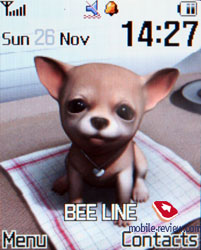

The keypad is made of a single plate with the buttons being soft and barely easy-to-press-in, but this doesn’t bring about any discomfort. All keys are evenly lit in white, which is well-visible in various environments. The four-way navigation key incorporates OK button. Under the keypad is a rubber pad preventing the pad from touching the display while the device is closed.



The handset utilizes standard 800 mAh Li-Ion battery; no more-capacious units are available, though. As the manufacturer claims, this battery can keep the phone up and running for 230 hours in standby mode and provide up to 3.5 hours of talk time. In conditions of Moscow networks the battery life made up about 3 days at 1 hour of calls and minimal usage of other functions. Should you be heavy on the built-in pedometer and music department, the lifetime will drop down to 2 days. It takes the E570 a tad less than two hours to charge up from empty to full.


Menu
The handset bases off Helios II platform (Gumi and Agere respectively) and draws its functionality from such models as Samsung E750/E760 (especially pedometer-wise). The handset carries 23.5 Mb of memory onboard, which can be expanded with a memory card. In terms of software the E570 is pretty muck the same as other up-to-date solutions.
Interface follows in the footsteps recent models: there are two high-contrast themes available, but that’s about it. Main menu can be displayed as grid (3x3) or as a list. All sub-menus have horizontal lists, in case there’s a third-level menu, you will see a pop-up window on the right of the highlighted item. You see which items are stored underneath, and once you press OK button – you will get there. In case you lean navigation leftwards or rightwards, you will be able to access corresponding item at once. Ergonomics of such solution is evident, at least one key-press gets saved every time you navigate the menus, and this is interesting solution developed by Samsung.
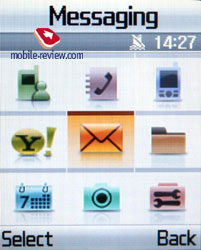
Another pleasant interface addition which is unique for Samsung phones is memorization of position in each sub-menu and main menu. Handset will “remember” which function you addressed last time, and will highlight it automatically next time you enter same menu item. For example you selected call list in main menu, done some operations in it, and next time you enter main menu you will have it highlighted in first place. But that’s not all; once you access it again you will see that sub-menu item which was addressed last will be highlighted too. It seems to be a simple thing, but it is not present in handsets produced by any other manufacturer.
When selecting one or another item in the list you will see it highlighted, and font size (which is big already) will be increased.
Shortcut number navigation is supported, but that’s not all options of menu navigation. You can bind three different applications from the list, offered by manufacturer (you will not be able to bind java applications). Leaning navi-key up will always activate My Menu, this is horizontal scroll with list of items. This list is identical to the one for simple shortcuts.
We should also mention Simple Search function, when you dial numbers and later on select Name search from options menu. In case handset finds a match in terms of letters (this means combination of letters with digits), then it will show a record in the phone book. Unusual feature which reminds me a little of a normal smartphone search prototype.
Phonebook. Contacts can be accessed by pressing right soft key, you will see a list that contains all entries from both SIM-card and phone’s memory. By default first name is highlighted, and you will see phone number in service text line (SIM-card entries are displayed with corresponding icon). Fast name search by first letters is supported; there can be up to twenty of those, for any language. Once you press OK key you will go into detailed view of selected entry. There you will see a thumbnail in case there had been one assigned. It can be an image or a photo. Each entry can have up to 5 phone numbers of different types (cellular, office, home, fax other), one of them will be main one (by default it is the first one you entered). All fields are fixed.
 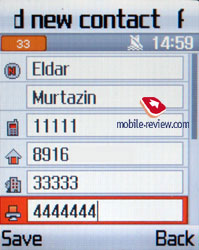
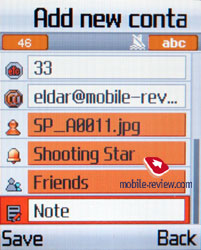 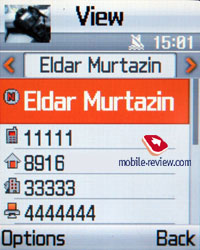
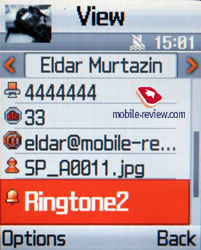 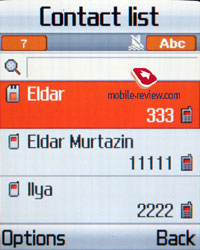
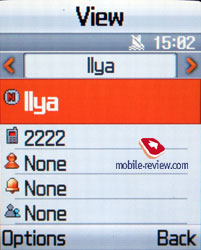 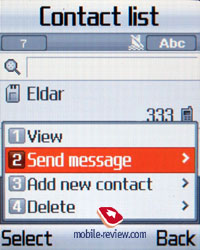
There are two lines for First Name and Last Name (search is conducted only by first field), fields get summed when displayed, Name comes first. For example Eldar Murtazin will be shown only in this order. Length of each field is 20 characters for any supported input language. You can also switch languages on the go when entering a name.
All entries, without regard to language, are sorted out under the algorithm – all contacts with headings made in a local language (Russian, for example) go first and then those with names in English. This is rather convenient and handy list sorting system. Taking into account fast language switch option during the search, it’s clear that no language will spoil the experience of working with this phone.
But let us return to the information entered for a contact. Apart from phone numbers, e-mail address (there may be several of them), a little text memo can be submitted on top of all that. Any music file as well as composed MP3's can be picked as a ring tone for a contact. Three caller groups are provided by default with the possibility for creating any number of additional groups, selecting a personal melody and image for each. SMS alerts are also customizable.

The phonebook is capable of holding up to 1000 contacts with filled in data fields. Even if all the available blanks are not used, the cap won’t get any bigger and will still make one thousand. It is possible to set in the settings where all new numbers should be kept by default. There is also an option for moving entries from the SIM-card although the vice versa action is denied. According to the developers, PC (MS Outlook in particular) is best for data synchronization with the D900. Any contact in the form of SMS/MMS, mail message or other text file can be quickly sent through Bluetooth to another device. There are no problems with sending and the phonebook entry being transmitted to another device, where it is read without any trouble.
The phonebook may contain a business card as well, though its structure copies all the fields applied to a regular contact in the phone book.
There can be up to eight numbers in the fast dial list; separate numbers tied up with a single contact may appear on this list as well. The subtitle of the chosen entry (not of the phone number type) is displayed on the buttons.
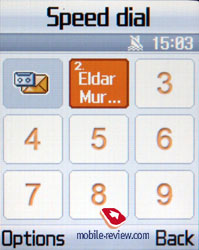
When receiving a call, a picture occupies not the entire screen, but only a part of it, however it still takes up a considerable area. At that only contact’s name gets displayed, while the number type remains hidden.
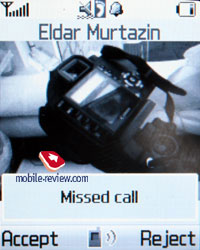
Call lists. Each of the given lists contains up to 30 phone numbers. There is a combined list of all the last calls with an icon indicating a call type. Deflecting the navi-pad horizontally, you can switch quickly from one list to another. The date and the time of a call without special note of duration are displayed in extended view for separate entries. Calls from/to one number are summarized, so that a number standing next to the call specifies total amount of calls made. In order to access duration data you will need to call up detailed information on desired item. As always, the overall time of the calls and their prices can be viewed in this menu (in case the service has been enabled).
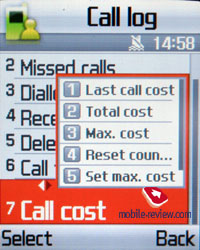 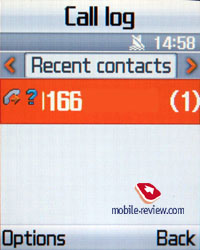
Messaging. Working with various types of messages is implemented through separate submenus. Let us begin with short messages. The phone memory can hold up to 200 messages simultaneously; the handset supports EMS standard compatible with Nokia Smart Messaging. T9 text input capability comes in handy and is easy to use. When at choosing recipient window, you can either select a telephone number from your contacts or pick one from the call lists or groups. All messages are manageable, this means you are at liberty to move a certain number to your black list, in order to make sure all messages coming from that phone number will be deleted automatically; possibility for moving messages to any own folder is also at your disposal. For e-mail you can move not only addresses to the blacklist, but unwanted subjects as well.
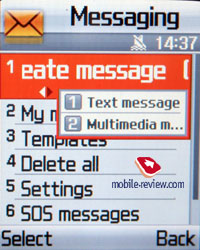 
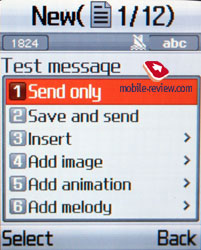 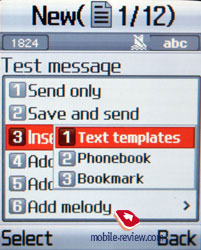
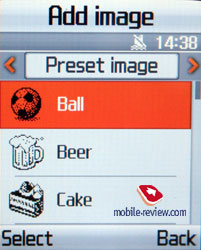 
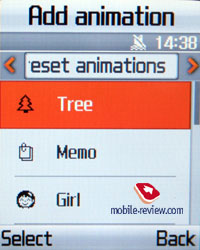 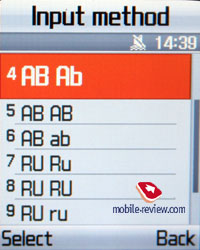

MMS. Interface for creating multimedia messages is pleasant to use, you can instantly save them in different folders. There is limitation for a message size (295kb), meanwhile incoming messages are not limited at all (though they may take up not more than the reserved memory volume). As for additional settings – there is option to disable advertisement reception, select weather messages be received during roaming or home network stay. Messages are stored in a separate memory block (3 Mb)

SOS Message is a new feature to the Samsung’s arsenal – here you need to submit telephone numbers that will receive messages with user-customizable text. To send such message all you have got to do is press the side key four times. However how useful this function is in light of missing GPS-receiver and coordinates tracking, is a big question; generally speaking, it’s nothing more but an addition to Mobile Tracker.
Planner. There can be up to 300 different events of three types (3x100) - meeting, affair and anniversary. The day and the time as well as end time of the even are indicated for each entry. Alert signal, as well as its duration can be adjusted according to your liking; repeatable events are available for setting up (at that repetition time is also adjustable as well as exclusion dates). The weekly and the monthly calendar views are very convenient with each type of the event having its own color.
 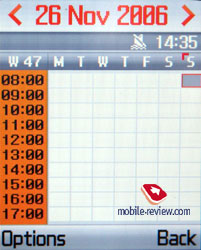
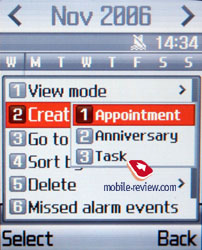 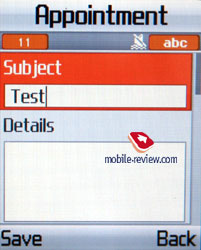
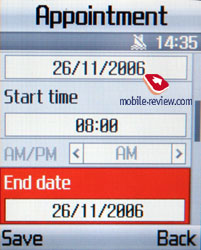 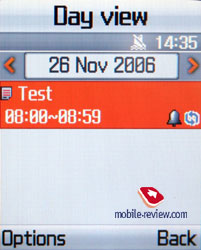
Speaking about the organizer’s shortcomings, I cannot overlook the fact that when typing date and time for an event, the end time doesn’t change, which badly hurts ease of use – other manufacturers make the due time shift automatically (by default an event takes one hour).
Tasks – a standard list of tasks with the possibility of stating priority.
WAP. There is a wap-browser ver. 2.0, similar to that carried by some phones by Nokia and Sony Ericsson, using http protocol. The browser automatically offers you standard prefixes and endings of the entered addresses. Although it’s packed with features, it would make more sense if you replace it with Opera Mini.
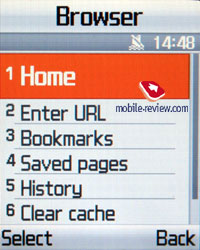
The main menu houses Yahoo Search item, which is a soft of bookmark enabling you to access the engine via the built-in browser. On majority of markets the company intends to use Yahoo-powered service, whereas in Russia handsets will come included with Google Search engine onboard.
Applications. MP3 player. An integrated mp3 player, supporting random track playback, sequential and cyclic, is available on the phone. Mp3 files can be uploaded to the phone both directly through Bluetooth and through a synchronization application. There are no limitations, placed on tags and names of music files.
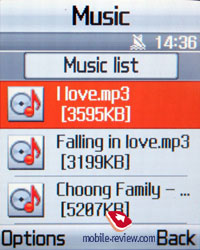 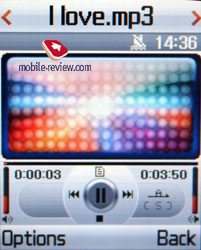
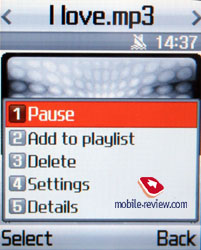 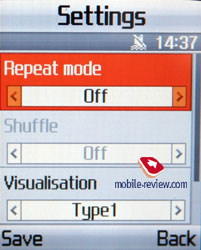
The title of the played back track is displayed as well as the number of the remaining tracks. The equalizer doesn’t make much sense, as there is no precise adjustment of audio controls (only a possibility to choose from classic, rock, jazz and normal sounding). The tracks can be played through the stereo headset as well as through the speakerphone (A2DP profile is missing in the handset). The volume bar has 10 scales on it. And of course user can make up playlists of his own. Player can work in minimized mode.
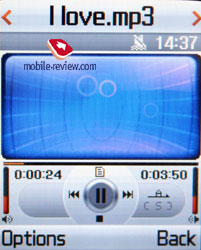
As for shortcomings, maximal number of playlists cannot exceed four. All music on memory card should be stored in a proper folder, sub-directories are not supported, root folders are not supported either. This is a series disadvantage for those who have big capacity memory cards, since it is not that convenient to drop all music into one folder.
Voice recorder. You can record up to several hours of voice memos with the number of files being unlimited. Basically, limitations on recording durations are set by user himself, though length of a single recording cannot exceed 1 hour. All the files are stored in a separate folder in the memory bank. The recorder performs well during lectures, conferences and presentations – I could even say that it is a partial substitute for a digital tape recorder.
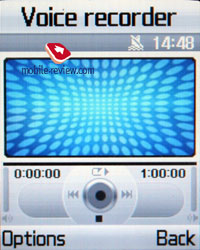 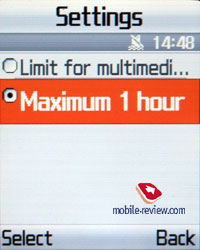
Java World. The handset carries 4 pre-installed games: BobbyCarrot, AirShip Racing, Arch Angel, Freekick and on top of that 4 Try&Buy ones. New applications can be downloaded only over the air, at that a JAR file can be no bigger than 300 Kb. Amount of memory reserved for Java-apps makes up 4 Mb.
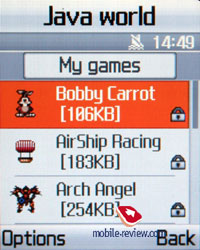 
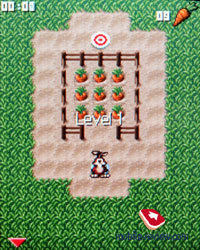 
 
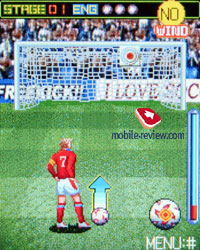
World time is displayed for two chosen cities. No world map here
Alarm clock. The phone is equipped with three alarm clocks. One is meant for mornings and can be set for selected weekdays as well as for weekends. For each of the alarm clocks there is a selection of five tunes, though necessity of them is questionable, as mp3 tracks can be used there as well. It is up to user to set up whether the phone will turn on automatically in the time of the event or not. Specific weekdays cannot be picked – the alarm clock triggers off only once or on all days.
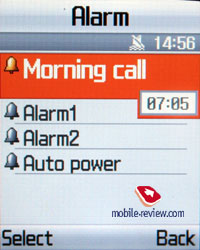 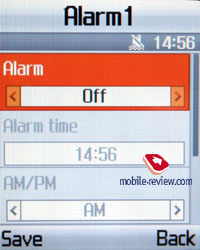
Calculator. It divides, multiplies, subtracts and adds and does several more things – quite enough for a mobile calculator.
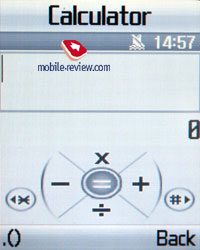
With the Converter, you can operate with different units of measurements as well as with a number of currencies.
 
Countdown timer and Stopwatch should be familiar to most users as well.
 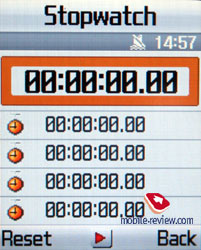
Memo – standard text notes.

File Manager (My files). That’s the place to search for all files such as music, pictures, video and sounds. Any uploaded file gets stored here. The disadvantage is that files sometimes are not displayed in the list immediately - in that case you will need to leave the menu and enter it again.
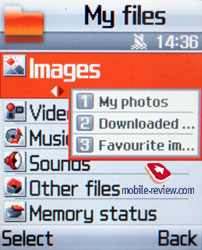
Files and folders can be viewed either as a list or as thumbnails. You can select any amount of files. The handset supports Move, Copy and Delete operations, as well as various types of sorting (by type, name or size)
Memory card’s file structure is a slightly different story, as it can be accessed through the main menu, where each item features “Memory card” option.
Settings. This item boasts a standard set of options inside - font color in the standby mode, password protection of selected sections (messages, short messages, organizer, etc.), backlighting duration and brightness, dialing display. Calling up Security item allows protecting certain functions and menus with password.
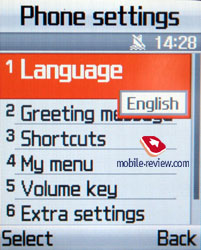 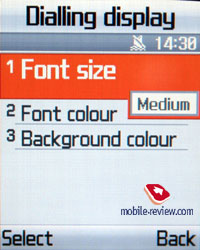
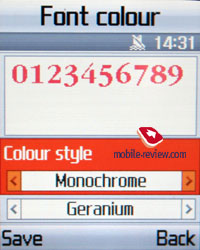
The side-mounted key can be set up to decline an incoming call or send a message to the caller, whose text you can edit in the settings.
Backlighting duration – there are three options at your disposal, one of them is Night mode , implying that backlighting will be active only between 5:00 PM and 9:00 AM and disabled during daylight. If you come and think of it, this feature nothing more but an illusive replacement for illumination indicator, which Motorola’s handsets are armed with.
Mobile Tracker – submit a phone number, where notifications will be sent to in case SIM-card was changed – that message will contain number of the SIM-card being used with the handset. This section is protected with password, so that no one other than you or someone else who knows the password could disable the Tracker. Should your device have the SIM-card switched once, the specified number will receive one message instantly, and one more each time a new card is plugged in. A fetching feature which can prove to be of much help in case the handset is lost or stolen.
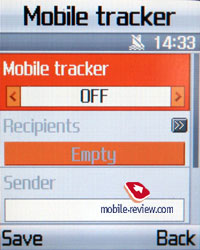 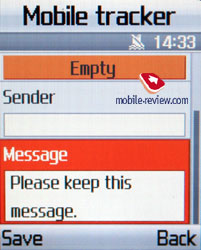
Flight mode – you can disable network part of handset.
The handset lacks profiles system and offers only adjustable events settings, which makes it look like it came from the past – for example, newest Samsung’s 3G devices have profiles onboard (though many other functions have disappeared). The P310 has got many vibrating alert modes and tunes in its sleeve, everything here works without any limitations, but what really frustrates me is inability to set an own tune for incoming SMS-message or e-mail – you are enabled to choose only from 10 pre-installed simple tunes found on the handset. On the other hand, ring tones are adjustable for contact groups, stand-alone entries in the phonebook and even for the alarm clock; therefore it’s somewhat obscure why not all alerts are customizable.
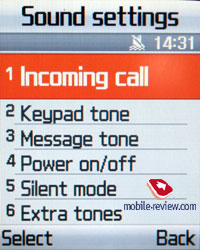 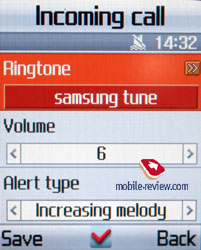
Bluetooth. The handset supports various profiles, namely, Headset, Handsfree, Serial Port, Dial Up Networking, File Transfer, Object Push. The Bluetooth realization is not ideal, troubles with headsets having only a Headset profile appear pretty often, and speakerphone is handled in improper way sometimes either. In general the Bluetooth found on the D900 is comparable to that on Nokia’s phones, but worse than on Sony Ericsson. Support for A2DP profile is missing.
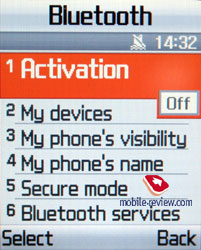 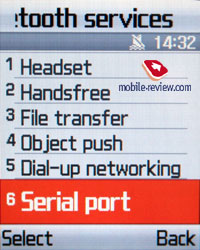
Women’s Life. Another big section featuring a couple of functions that will appeal to women only (the item’s title, though, has already said it all).
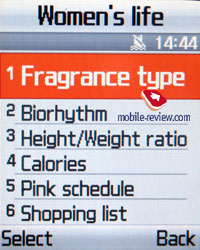
The first one should be familiar to you, if you’ve had a chance to play around with other devices in this range (Fragrance Type): you choose certain preferences, while the handset processes them and recommends one or another fragrance and what perfume will suit you best.
Biorhythms are available for a selected day or month, acquired data can be sent to another handset via SMS messages. A good thing about the Biorhythms is the alarm that will keep on informing you about current conditions of yours daily.
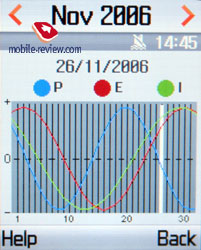
Hegiht/Wegiht ratio applies a standard formula for all calculations – you just enter you height, sex, and weight, the E500 will take care of everything else.
 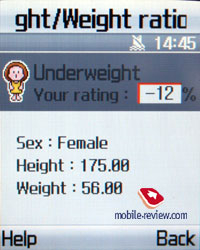
Calories. Here you can choose a day and then, using a guide, submit various activity types and time you spent on them. In the end the handset will output total amount of calories burnt.
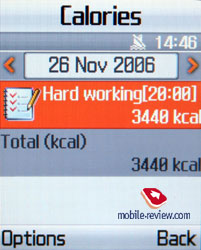
Calculation of menstrual cycle and a calendar with monthly view are available.
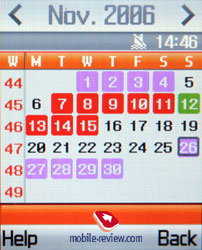 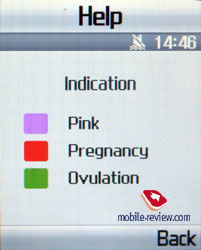
Shopping list. There are 5 shopping bags in sum available for filling up; each of them can contain various goods of certain price. In its turn, the E570 calculates total cost. This feature comes in handy only when you are doing shopping – you just tick off items as you go further on your to-buy list.
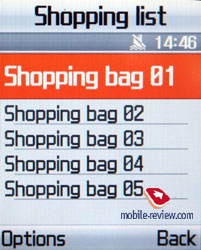 
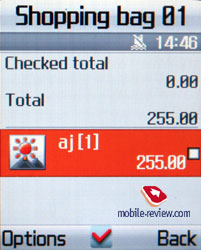
Pedometer. On the release of Samsung E750/E760 we wrote literally the following about the built-in pedometer:
“In fact, we see no use in the motion sensor, and all the points where it's used seem far-fetched. The potential of the technology and not the current realization really fascinate. Let's guess what can be done using the sensors in phones. Pedometer and a corresponding application come to mind. Not only the number of the steps can be calculated, but a walk diary, calculation of the lost calories, distances and so on can be carried out. That would be a good application for those who tries keeping fit and has no time for fulltime trainings, that's why the main training is walking and jogging. Try to guess other applications for the sensor, and describe them in our forum, that'll be good brain gymnastics.”
And we are truly pleased to know that over at Samsung there are people who call at our portal and do their best to fix the omissions found in the handsets according to the information they pick up here. But a special credit here goes to releases of such pedometer-equipped models as Nokia 5500, Sony Ericsson W710i.
Samsung E570’s pedometer can be minimized, which is a very simple thing to do – you need to start it up and switch to any other menu, confirming that you would like to keep the pedometer running. Information on amount of steps made will eventually pop up on the external screen.
The application logs all results, so that you can check out distance covered in course of a day or a week (graphic). To estimate calories burnt in a proper way, you will have to submit your personal data (weight, height), also the E570 presents you with planner feature, meaning that you can set goals (for example steps made or calories burnt) and configure a special alert to trigger off when the time is right. The broad audience will be mostly satisfied both with the very presence of this application and its capabilities.
The accuracy delivered by the E570’s pedometer on flat country is pretty much satisfactory, nevertheless while driving, be sure your handset will keep on counting steps, since it is set up to react to minor movement amplitude and doesn’t boast any adaptive algorithms, like those embedded in Nokia- and Sony Ericsson-branded solutions, which leads us straight to the fact that with Samsung E570 you get worse accuracy. To prove this way of thinking we took a standard stand-alone pedometer and during a workday used it along with Samsung E570, Nokia 5500, Sony Ericsson W710i. The results turned out to be of some interest, since the lowest amount of steps blazed up on the electronic pedometer’s display, so that we calculated errors made by the rest of devices and turned them into percents (the greater the figure – the worse):
- Samsung E570 – 37%
- Sony Ericsson W710i – 17%
- Nokia 5500 – 14.5%
It is clear that pedometers built in mobile devices today can show off only considerable degree of error, which can be found out even with a naked eye, but with this said, Samsung E570 is twice as worse as its mobile rivals, but it isn’t the end of the world for Samsung, since they still can tune the algorithm to make it more precise.
The motion sensor presents you with a very fetching undocumented feature – there is a funny-looking dog among pre-installed pictures (though you might not have it on your handset), and if you shake the handset while at the standby screen, the dog will start moving its head – marvelous!

Camera. The camera module is 1.3 Mpix and equal to the majority of Samsung’s last generation models or, for instance, Samsung E500 (the differences are almost non-existent or concern a couple of options). The camera is pretty typical build-wise and allows taking photos of fairly good quality. However the snaps are good for demonstrating on the handset’s screen only, as they look not very appealing on a PC’s screen.
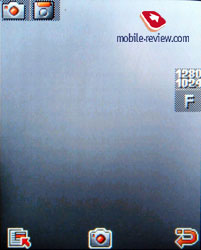 
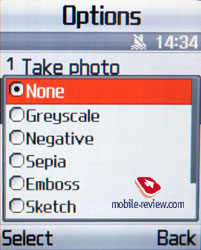 
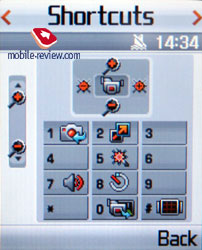
The camera can work in 6 different resolutions:
- 1280x1024
- 1152x864
- 800x600
- 640x480
- 320x240
- 176x144
The compression quality for JPEG pictures is set separately, several types are available:
There are 5 different sounds for the shutter in the E570, excluding the silent mode, when the process of taking photos won't draw anyone’s attention. Default file name, the sensitivity of the matrix (Auto, ISO 100, ISO 200, ISO 400) are available for adjustment. I'd recommend using Auto mode since it allows getting correct settings in majority of cases. The difference between sensitivity modes is quite hard to notice in normal conditions – in fact you won't see any changes on the photo.
The timer for self shooting can be set for 3, 5 or 10 seconds.
The mosaic mode switches the camera to the lowest resolution (a final picture is 640 x 480 pixels) and you get a picture that consists of 4 or 9 items (2x2 or 3x3). A feature of some interest should you be willing to carry out some experiments.
In the multi shot mode it's possible to select some series, in particular that may be 6 photos with high speed (practically immediate pictures), with normal speed (the period between the photos is a second or less). Also modes with 9 and 15 photos are available. I'll note that the function is interesting as a photofinish at a competition, in real life if moving the camera the photos will get blurry in the majority of cases. The resolution is 320x240 in this mode.
Describing separate functions, we completely forgot to tell about switching into the shooting mode, which is done either by pressing the side button or via the menu. The screen of the phone serves as a viewfinder, using the navigation button you may change the contrast level and use zoom. When the resolution reaches the maximum level, zoom turns off automatically. The picture may be mirrored on the screen using side buttons.
There is a standard set of effects in the phone that may be applied in course of either shooting or editing. As for me, the second way is more acceptable just like applying frames to the photos. We'll just list the effects here: Black & White, Negative, Sepia, Emboss, Sketch, Antique, Moonlight.
The photos are kept in the album, where you may view the data on a certain photo. The list gets formed fast and indicates the phone name and a small icon. Any photo may be assigned to a contact in the phone book or set as wallpaper right from the album menu. There is a slide show mode, a basic editor that allows adding emotion icons, apply frames and effects to the photos.
 |
 |
(+)
maximize, 1280x1024, JPEG |
(+)
maximize, 1280x1024, JPEG |
 |
 |
(+)
maximize, 1280x1024, JPEG |
(+)
maximize, 1280x1024, JPEG |
 |
 |
(+)
maximize, 1280x1024, JPEG |
(+)
maximize, 1280x1024, JPEG |
 |
 |
(+)
maximize, 1280x1024, JPEG |
(+)
maximize, 1280x1024, JPEG |
 |
 |
(+)
maximize, 1280x1024, JPEG |
(+)
maximize, 1280x1024, JPEG |
 |
 |
(+)
maximize, 1280x1024, JPEG |
(+)
maximize, 1280x1024, JPEG |
 |
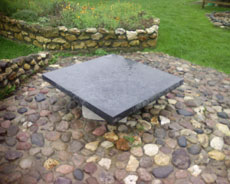 |
(+)
maximize, 1280x1024, JPEG |
(+)
maximize, 1280x1024, JPEG |
 |
 |
(+)
maximize, 1280x1024, JPEG |
(+)
maximize, 1280x1024, JPEG |
 |
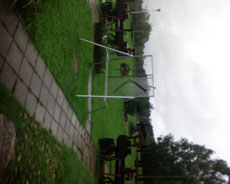 |
(+)
maximize, 1280x1024, JPEG |
(+)
maximize, 1280x1024, JPEG |
The phone records 3GP video and you may choose recording with sound or without it. All the settings are comparable with similar for photos, the same 3 quality levels but the resolutions are different. The maximum resolution is 176õ144 pixels (other available resolutions:160õ120, 28õ96). Maximum duration of a clip is up to free memory only, though for MMS-attachments there is a mode limiting the size of a recording to 100 Kb.
Video sample (mp4, 336 Kb)>>>
PC Synchronization. You can synchronize your data with help of data cable or Bluetooth. Easy Studio 3.0 can be downloaded from the company’s web-site.
Impressions
The model delivers good connection quality, which is typical for all up-to-date handsets. The loudspeaker outputs clear and penetrating sound. The volume of the 64-chord polyphony is average, while mp3 tunes are loud enough to make the handset literally blow you away even on a busy street. The power of the silent alert is average.
Undoubtedly, the E570 is remarkable for utilizing dated platform and disappointing restrictions on over-the-air uploading, enabled size of applications, missing mail client and Vivid Message, and impossibility to set video as a contact’s identifier and modify message alert. On the other hand, most of these features are not called for by girls, and over at Samsung they clearly understand this. As for camera, the handset’s target audience applies it only for on-screen viewing of snaps, without bothering with throwing them onto PCs. USB Mass Storage and its absence are not that crucial, taking account of the number of things appealing to the E570’s target audience, which are, in fact, many: smooth design, unique external display, a set of only-for-women apps, pedometer and modern interface. So that it turns out the audience Samsung is targeting with this phone gets almost a perfect solution, and it wouldn’t be a great upset if the E570 had a price equal to that of Samsung E500. But instead it will be retailed for about 350 USD, which looks really attractive and makes it a marvelous offering price/quality ratio-wise. The fact of the matter is that Samsung E570 hasn’t got any direct competitors on the horizon, which is pretty strange in the first place. As for its indirect rivals, fold phones by other manufacturers, specifically Sony Ericsson W710i might do as well, but the handset we have just mentioned is a step behind due to being a highly tailored proposal (as it’s not a women-only model), picked mostly by music lovers, which means that the target audience almost don’t overlap. Motorola PEBL aims pretty much at the same audience, is on a par or proves to be a tad better in the sense of design, but lags behind in terms of extra features, even though its price tag is much less hefty.
Wrapping it all up, we can say that Samsung has managed to come up with one of the best solutions for women to day – make no doubt about that.
Related links:
Eldar Murtazin (eldar@mobile-review.com)
Translated by Oleg Kononosov (oleg.kononosov@mobile-review.com)
Published — 29 December 2006
Have something to add?! Write us... eldar@mobile-review.com
|
News:
[ 31-07 16:21 ]Sir Jony Ive: Apple Isn't In It For The Money
[ 31-07 13:34 ]Video: Nokia Designer Interviews
[ 31-07 13:10 ]RIM To Layoff 3,000 More Employees
[ 30-07 20:59 ]Video: iPhone 5 Housing Shown Off
[ 30-07 19:12 ]Android Fortunes Decline In U.S.
[ 25-07 16:18 ]Why Apple Is Suing Samsung?
[ 25-07 15:53 ]A Few Choice Quotes About Apple ... By Samsung
[ 23-07 20:25 ]Russian iOS Hacker Calls It A Day
[ 23-07 17:40 ]Video: It's Still Not Out, But Galaxy Note 10.1 Gets An Ad
[ 19-07 19:10 ]Another Loss For Nokia: $1 Billion Down In Q2
[ 19-07 17:22 ]British Judge Orders Apple To Run Ads Saying Samsung Did Not Copy Them
[ 19-07 16:57 ]iPhone 5 To Feature Nano-SIM Cards
[ 18-07 14:20 ]What The iPad Could Have Looked Like ...
[ 18-07 13:25 ]App Store Hack Is Still Going Strong Despite Apple's Best Efforts
[ 13-07 12:34 ]Infographic: The (Hypothetical) Sale Of RIM
[ 13-07 11:10 ]Video: iPhone Hacker Makes In-App Purchases Free
[ 12-07 19:50 ]iPhone 5 Images Leak Again
[ 12-07 17:51 ]Android Takes 50%+ Of U.S. And Europe
[ 11-07 16:02 ]Apple Involved In 60% Of Patent Suits
[ 11-07 13:14 ]Video: Kindle Fire Gets A Jelly Bean
Subscribe
|


























































































































